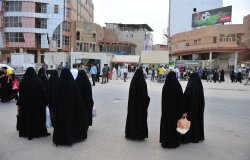Beyond Collateral Damage: Femicides, Disappearances, and New Trends in Gender-Based Violence in Mexico
Gender-based violence (GBV) is on the rise in Mexico, and the drivers of femicides, sexual violence, and disappearances are evolving, revealing intricate connections between criminal networks, state-sponsored violence, and domestic forms of abuse.
Over the last ten years, an overall increase in the number of femicides and in the levels of lethal violence impacting women has put Mexico in the national and international spotlight. In a country where public conversations on matters of security and violence seem too often dominated by drug-related violence and the societal impact of the so-called war on drugs, feminist organizations, women activists, and the family members of victims of GBV have managed to break the silence that has for too long minimized the extent of this violence. Moreover, feminist activists and organizations have shown that the violence that women experience is neither marginal nor separated from the crisis of insecurity affecting the country, but is, instead, a central expression of the institutional, cultural, and structural factors behind it. Namely, these forms of violence are linked to militarized masculinities, internalized misogyny, punitive forms of security provision, the rampant availability of guns, and pervasive impunity driven by gendered, social, and racial discrimination.
In this policy brief, we look at the numbers and new trends regarding gender-based violence in Mexico. In particular, we discuss the prevalence of femicides, and the important – but often overlooked – phenomenon of disappearances and its rising impact on women and girls. While femicides have received much-needed media and public attention, disappearances have rarely been discussed, let alone incorporated into policy actions or recommendations. Furthermore, in this piece we underscore how women searching for the disappeared face not only discrimination and hostility, but also overt violence and potentially murder.
How these forms of violence relate to and reinforce one another is a question that demands a clearer answer so that more effective policy interventions may be developed. This is a story of gendered vulnerability and increasing re-victimization, but also one that shows the courage and perseverance of women facing violence.
Female homicides and femicides: numbers and new trends
Statistics on gender-based violence in Mexico are disconcerting: around 10 women are murdered every day in the country. In 2022 alone, a total of 3,754 women and girls were murdered, according to data from the Executive Secretariat of the National Public Security System. Of this total number of cases, only 947 were investigated as femicides (defined as the intentional killing of a woman because of her gender). In fact, some civil society organizations suggest that state authorities may sometimes classify femicides as homicides to artificially lower femicide statistics. Most of these murders were concentrated in Guanajuato, Baja California, Estado de México, and Michoacán, which are also some of the most violent states in the country, based on homicide levels.
The correlation between the geography of female homicides/femicides and that of violence more broadly confirms the findings of a 2020 study published by the Mexican feminist organization, Intersecta. According to this study, gender-based violence no longer takes place primarily in the private sphere, but it is becoming more frequent for GBV to occur in public spaces. Recent cases have been reported in highways, construction sites, railroad yards, or outside the workplace, and the bodies of victims have been found in water tanks and mass graves. Moreover, this violence is increasingly perpetrated with firearms, and is linked to public confrontations between armed forces and non-state armed actors, or amongst criminal organizations.
In other words, gender-based violence is becoming progressively more tied to criminal and state-forms of violence and has been negatively impacted by the country’s mounting militarization of civilian forces. Moreover, evidence suggests that women’s vulnerability and exposure to domestic forms of abuse is deepening as public resources and institutions dedicated to the prevention and reduction of gender-based violence are being defunded as public spending is increasingly allocated to the military.
The disappearance of women: an overlooked phenomenon
In addition to femicides and lethal violence against women, families of victims and civil society organizations have recently denounced and demanded a public response to the disappearances of girls and women, a phenomenon that has a clear gendered dimension and that has so far remained understudied and under explored.
Mexico has officially registered over 110,000 missing people. A recent report from a Mexican human rights organization notes that over the last six years, the number of disappeared women and girls has tripled. More than half of these cases take place in only eight states, and all of these states have active “Gender Violence Alerts” which means that local, state, and federal authorities are supposed to actively work together to prevent gendered forms of violence. The geographic concentration at the municipal level is striking, as only 49 municipalities and five alcaldías in Mexico City concentrate 41.4% of all women and girls’ disappearances in Mexico (out of a total of 2468 municipalities and 16 alcaldías). The majority of these missing women and girls are between 15 and 19 years old.
In the state with the greatest number of homicides against women, Guanajuato, a recentreport indicated that an average of three women and girls disappear every day. Of the total number of female disappearances, 50% are concentrated in five of the 46 municipalities in the state. As the report makes clear, these disappearances take place against the backdrop of dynamics of pervasive domestic abuse, increasing militarization, and heightened confrontations between state and non-state armed actors, including criminal organizations linked to the illicit drug economy and to the theft and illicit sale of fuel.
The phenomenon of disappearances and gender-motivated murders of women and girls is worsening, and the linkages between these two forms of violence need to be better understood and addressed. Severe underreporting, poor, truncated, or non-existent judicial investigations, discrimination and prejudices on behalf of public officials that results in the re-victimization of women and their families, and rampant impunity are just some of the challenges that undergird disappearances and femicides. Adding to this difficult context, women in search of their disappeared loved ones are particularly vulnerable to gender-based violence, and face harassment, retaliation, and even death as a result of their activism.
Gendered risks for women searching for the disappeared
Searching for the disappeared in Mexico is a high-risk activity, and the women that engage in these activities face unique dangers. The vast majority of those who dedicate themselves to making demands for truth and justice are women – the so-called madres buscadoras. In the course of their activism, they are often isolated from their families and communities, and vilified and threatened by both state authorities and criminal elements related to organized crime. Many report feelings of isolation and deteriorating health.
A recent report by the Instituto Mexicano de Derechos Humanos y Democracia A.C.documents the ways in which mothers and family members participating in the search receive “hostile treatment by authorities.” They are “discriminated against, stigmatized, mistreated, defamed, and have their reputations damaged by institutional practices.” The report notes that this mistreatment is based in gendered stereotypes, particularly when the missing loved ones are women and girls. For example, it notes that victims’ honour and dignity are called into question when the authorities assume that their disappearance was “provoked… for being in ‘bad company’, ‘running away with her boyfriend’ or ‘having connections with criminals.’”
In fact, madres buscadoras have been killed while searching for their loved ones. In May, Teresa Magueyal was murdered in Celaya, Guanajuato; she was the fourth buscadora to be killed in this state since 2020. In 2010,Marisela Escobedo was shot on the steps of the Government Palace in Chihuahua, hours after a protest in which she made demands on the government to investigate the case of her daughter, Rubí, who was a victim of femicide in 2008. Other women have been shot, stabbed, stalked, and threatened for their public activism. Ceci Flores, a prominent activist in Sonora, frequently posts on Twitter about the death threats she receives, which demand that she stop searching for her two missing sons.
Our own academic research documents how women negotiate hierarchies of fear to search for their missing loved ones, despite these risks of violence. Drawing on fieldwork with a group of madresbuscadoras in Veracruz, the research highlights the ways in which participating in their activism – including protests and marches, legal activism, and physically searching for the remains of their children – presents particularly gendered risks. It also theorizes how these mothers draw on their feelings of love and care, anger and moral outrage to justify their ongoing participation in this high-risk activism. As Ceci Flores frequently says: “the love for a child is greater than fear.”
Women in the face of violence: a tentative roadmap to addressing GBV in Mexico
Gender-based violence is worsening in Mexico, and has undergone important changes and transformations over the last ten years. Recent evidence suggests women’s lives and physical integrity are being directly impacted by intensifying militarization, by confrontations between state and non-state armed actors, and by the proliferating availability of firearms. Moreover, the disappearance of women and girls is on the rise, and given the problems of underreporting and deep-seated impunity the country faces, we can assume the numbers are actually much higher. Given the multiplication of clandestine graves across the country, many of these cases of missing women and girls can likely be related to femicides or unresolved murders, however these cases do not figure amongst femicide statistics.
The mistreatment and potential victimization of women activists searching for the disappeared adds another layer of vulnerability for women. In a country where some state officials are negligent or actively complicit in cases of GBV, the fact that female activists are being targeted by criminal organizations, state actors, or both, means that those that have been able to denounce and demand action on behalf of state authorities risk being silenced, harassed, or even killed.
The current scenario demands immediate actions on behalf of Mexican authorities. A tentative roadmap to address GBV Mexico should include at the very least the following policy responses:
1) Produce better and more accurate data on GBV. As a recent study indicated that in Mexico, the quality of data and the sources used to build it lack quality and robust methodologies, “leading to a complex labyrinth, which increasingly re-victimizes and is incapable of achieving inter-institutional coordination.” Civil society organizations and individuals are already producing some of this femicide and disappearances data; the state could work collaboratively with them to take a feminist approach to data science.
2) Develop a better understanding of the connections between femicides, disappearances, and other forms of GBV, including sexual exploitation and sex trafficking, which arecurrently poorly understood due to the risks and threats associated with investigating these crimes. This understanding requires judicial investigation and intelligence gathering, but should also encourage collaboration between government institutions, activists, and leading civil society organizations in the country.
3) Step up efforts to prevent– rather than simply respond to –structural gendered violence and reassess the country's security strategy with a feminist perspective, sensitive to linkages between militarization and GBV. Both domestic responses and security cooperation efforts with the United States in the context of theBicentennial Framework should move away from militarized and punitive responses and restore and strengthen programs and initiatives aimed at addressing gender-based violence.
4) Re-design or modify specific security measures to protect those women who put themselves in harm’s way by actively searching for disappeared women and girls. Madres buscadoras ask to be recognized not only as mothers, but as human rights defenders, which gives them access to protection mechanisms. They should also be granted these protection mechanisms to better meet their needs, including options for collective protection and protocols for when they travel outside their home state or at night.
About the Authors

Mexico Institute
The Mexico Institute seeks to improve understanding, communication, and cooperation between Mexico and the United States by promoting original research, encouraging public discussion, and proposing policy options for enhancing the bilateral relationship. A binational Advisory Board, chaired by Luis Téllez and Earl Anthony Wayne, oversees the work of the Mexico Institute. Read more













